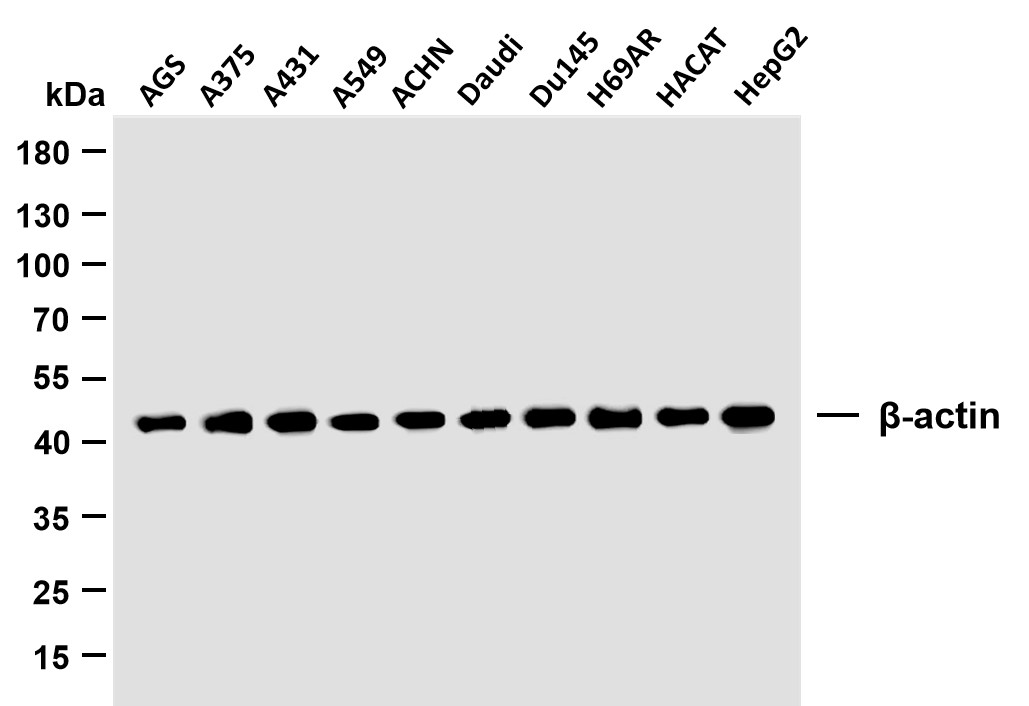
主要信息
Target
CR3L4
Host Species
Rabbit
Reactivity
Human, Mouse, Rat
Applications
WB, ELISA
MW
43kD (Observed)
Conjugate/Modification
Unmodified
货号: YN0319
规格
价格
货期
数量
200μL
¥3,780.00
现货
0
100μL
¥2,300.00
现货
0
40μL
¥960.00
现货
0
加入购物车


已收藏


收藏
详细信息
推荐稀释比
WB 1:500-2000; ELISA 1:5000-20000
组成
Liquid in PBS containing 50% glycerol, and 0.02% sodium azide.
特异性
CR3L4 Polyclonal Antibody detects endogenous levels of protein.
纯化工艺
The antibody was affinity-purified from rabbit antiserum by affinity-chromatography using epitope-specific immunogen.
储存
-15°C to -25°C/1 year(Do not lower than -25°C)
浓度
1 mg/ml
实测条带
43kD
修饰
Unmodified
克隆性
Polyclonal
同种型
IgG
相关产品
抗原&靶点信息
免疫原:
Synthesized peptide derived from human protein . at AA range: 200-280
展开内容
特异性:
CR3L4 Polyclonal Antibody detects endogenous levels of protein.
展开内容
基因名称:
CREB3L4 AIBZIP CREB4 JAL
展开内容
蛋白名称:
Cyclic AMP-responsive element-binding protein 3-like protein 4 (cAMP-responsive element-binding protein 3-like protein 4) (Androgen-induced basic leucine zipper protein) (AIbZIP) (Attaching to CRE-like 1) (ATCE1) (Cyclic AMP-responsive element-binding protein 4) (CREB-4) (cAMP-responsive element-binding protein 4) (Transcript induced in spermiogenesis protein 40) (Tisp40) (hJAL) [Cleaved into: Processed cyclic AMP-responsive element-binding protein 3-like protein 4]
展开内容
背景:
This gene encodes a CREB (cAMP responsive element binding) protein with a transmembrane domain which localizes it to the ER membrane. The encoded protein is a transcriptional activator which contains a dimerization domain, and this protein may function in a number of processing pathways including protein processing. Multiple transcript variants encoding different isoforms have been found for this gene. [provided by RefSeq, Dec 2011],
展开内容
功能:
Function:Transcriptional activator that may play a role in the unfolded protein response. Binds to the UPR element (UPRE) but not to CRE element. Preferentially binds DNA with to the consensus sequence 5'-T[GT]ACGT[GA][GT]-3' and has transcriptional activation activity from UPRE. Binds to NF-kappa-B site and has transcriptional activation activity from NF-kappa-B-containing regulatory elements.,induction:By androgens.,PTM:Controlled by regulated intramembrane proteolysis (RIP). Following ER stress a fragment containing the cytoplasmic transcription factor domain is released by proteolysis. The cleavage seems to be performed sequentially by site-1 and site-2 proteases (PS1 and PS2). PS1 cleavage may be suppressed by a determinant in the C-terminal region.,PTM:N-glycosylated in the C-terminal region.,similarity:Belongs to the bZIP family. ATF subfamily.,similarity:Contains 1 bZIP domain.,subcellular location:May also be located in Golgi apparatus.,subcellular location:Under ER stress the cleaved N-terminal cytoplasmic domain translocates into the nucleus.,subunit:Binds DNA as a dimer.,tissue specificity:According to PubMed:11830526 exclusively expressed in the prostate. Expressed in breast and prostate cancer cell lines. Expressed in prostatic luminal epithelial cells (at protein level). Expression is significantly more abundant in prostate cancer than in benign prostatic tissue (prostatic hyperplasia). According to PubMed:12111373 also expressed in brain, pancreas and skeletal muscle, and at lower levels in small intestine, testis, leukocyte and thymus.,
展开内容
细胞定位:
Endoplasmic reticulum membrane; Single-pass type II membrane protein. Golgi apparatus membrane ; Single-pass type II membrane protein . May also be located in Golgi apparatus.; [Processed cyclic AMP-responsive element-binding protein 3-like protein 4]: Nucleus. Under ER stress the cleaved N-terminal cytoplasmic domain translocates into the nucleus. .
展开内容
组织表达:
According to PubMed:11830526, exclusively expressed in the prostate. Expressed in breast and prostate cancer cell lines. Expressed in prostatic luminal epithelial cells (at protein level). Expression is significantly more abundant in prostate cancer than in benign prostatic tissue (prostatic hyperplasia). According to PubMed:12111373, also expressed in brain, pancreas and skeletal muscle, and at lower levels in small intestine, testis, leukocyte and thymus.
展开内容
研究领域:
>>cGMP-PKG signaling pathway ;
>>cAMP signaling pathway ;
>>PI3K-Akt signaling pathway ;
>>AMPK signaling pathway ;
>>Longevity regulating pathway ;
>>Adrenergic signaling in cardiomyocytes ;
>>TNF signaling pathway ;
>>Thermogenesis ;
>>Cholinergic synapse ;
>>Dopaminergic synapse ;
>>Insulin secretion ;
>>Estrogen signaling pathway ;
>>Melanogenesis ;
>>Thyroid hormone synthesis ;
>>Glucagon signaling pathway ;
>>Aldosterone synthesis and secretion ;
>>Relaxin signaling pathway ;
>>Cortisol synthesis and secretion ;
>>Parathyroid hormone synthesis, secretion and action ;
>>Insulin resistance ;
>>Cushing syndrome ;
>>Growth hormone synthesis, secretion and action ;
>>Vasopressin-regulated water reabsorption ;
>>Huntington disease ;
>>Prion disease ;
>>Cocaine addiction ;
>>Amphetamine addiction ;
>>Alcoholism ;
>>Hepatitis B ;
>>Human cytomegalovirus infection ;
>>Human papillomavirus infection ;
>>Human T-cell leukemia virus 1 infection ;
>>Viral carcinogenesis ;
>>Chemical carcinogenesis - receptor activation ;
>>Prostate cancer
>>cAMP signaling pathway ;
>>PI3K-Akt signaling pathway ;
>>AMPK signaling pathway ;
>>Longevity regulating pathway ;
>>Adrenergic signaling in cardiomyocytes ;
>>TNF signaling pathway ;
>>Thermogenesis ;
>>Cholinergic synapse ;
>>Dopaminergic synapse ;
>>Insulin secretion ;
>>Estrogen signaling pathway ;
>>Melanogenesis ;
>>Thyroid hormone synthesis ;
>>Glucagon signaling pathway ;
>>Aldosterone synthesis and secretion ;
>>Relaxin signaling pathway ;
>>Cortisol synthesis and secretion ;
>>Parathyroid hormone synthesis, secretion and action ;
>>Insulin resistance ;
>>Cushing syndrome ;
>>Growth hormone synthesis, secretion and action ;
>>Vasopressin-regulated water reabsorption ;
>>Huntington disease ;
>>Prion disease ;
>>Cocaine addiction ;
>>Amphetamine addiction ;
>>Alcoholism ;
>>Hepatitis B ;
>>Human cytomegalovirus infection ;
>>Human papillomavirus infection ;
>>Human T-cell leukemia virus 1 infection ;
>>Viral carcinogenesis ;
>>Chemical carcinogenesis - receptor activation ;
>>Prostate cancer
展开内容
信号通路
Organismal Systems >> Endocrine system >> Insulin secretion
Organismal Systems >> Endocrine system >> Glucagon signaling pathway
Organismal Systems >> Endocrine system >> Estrogen signaling pathway
Organismal Systems >> Endocrine system >> Relaxin signaling pathway
Organismal Systems >> Endocrine system >> Growth hormone synthesis, secretion and action
Organismal Systems >> Endocrine system >> Aldosterone synthesis and secretion
Organismal Systems >> Circulatory system >> Adrenergic signaling in cardiomyocytes
Organismal Systems >> Nervous system >> Cholinergic synapse
Organismal Systems >> Nervous system >> Dopaminergic synapse
Organismal Systems >> Aging >> Longevity regulating pathway
Human Diseases >> Cancer: specific types >> Prostate cancer
Human Diseases >> Neurodegenerative disease >> Huntington disease
Human Diseases >> Neurodegenerative disease >> Prion disease
Environmental Information Processing >> Signal transduction >> TNF signaling pathway
Environmental Information Processing >> Signal transduction >> cAMP signaling pathway
Environmental Information Processing >> Signal transduction >> cGMP-PKG signaling pathway
Environmental Information Processing >> Signal transduction >> PI3K-Akt signaling pathway
Environmental Information Processing >> Signal transduction >> AMPK signaling pathway
文献引用({{totalcount}})
货号: YN0319
规格
价格
货期
数量
200μL
¥3,780.00
现货
0
100μL
¥2,300.00
现货
0
40μL
¥960.00
现货
0
加入购物车


已收藏


收藏
Recently Viewed Products
Clear allToggle night Mode
{{pinfoXq.title || ''}}
Catalog: {{pinfoXq.catalog || ''}}
Filter:
All
{{item.name}}
{{pinfo.title}}
-{{pinfo.catalog}}
主要信息
Target
{{pinfo.target}}
Reactivity
{{pinfo.react}}
Applications
{{pinfo.applicat}}
Conjugate/Modification
{{pinfo.coupling}}/{{pinfo.modific}}
MW (kDa)
{{pinfo.mwcalc}}
Host Species
{{pinfo.hostspec}}
Isotype
{{pinfo.isotype}}
产品 {{index}}/{{pcount}}
上一个产品
下一个产品
{{pvTitle}}
滚轮缩放图片
{{pvDescr}}



















